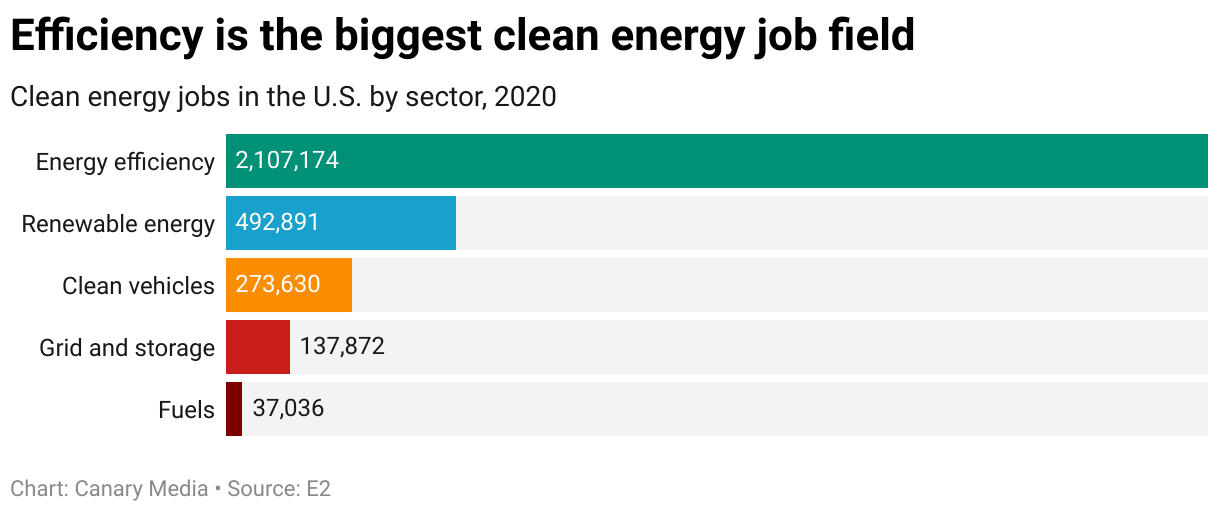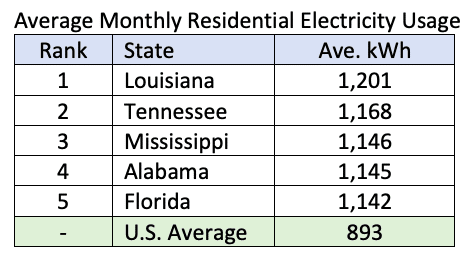The surprising fact is energy efficiency employs more than 2 million workers, which is over four times more jobs than solar, wind, coal, and fossil gas combined.
Forest Bradley-Wright | December 22, 2021 | Energy Efficiency, UtilitiesClean energy is not only the power we generate but also the power we save – a.k.a. energy efficiency. Every kilowatt-hour saved through efficiency reduces the need for energy from fossil fuel power plants – thereby eliminating harmful carbon emissions.
What is Energy Efficiency?
By comparison to solar and wind energy, or even traditional fossil fuel power plants, energy efficiency is humble and often common sense. Solar power, for instance, is highly visible – both in the news and on top of people’s houses. While just as important, most energy efficiency improvements are not nearly as recognizable because they tend to be located in hard-to-see places, or else they’re hiding in plain sight. Here are just a few examples:
- Insulation in attics, walls, and under floors
- Door sweeps, caulk, and foam used to seal air leaks around windows, doors, and plumbing penetrations
- Heating and air conditioning systems, ductwork, and thermostats
- Water heaters, appliances, and household electronics
- LED Lighting and controls
And the list goes on and on. There are literally thousands of energy efficiency measures, each one fitting seamlessly into our ordinary lives. They use less energy than the standard version of the same products, or they help to reduce structural loss of thermal energy (in other words, they keep your heat and air conditioning inside your home). The opportunities for efficiency are endless if often underappreciated…especially in the Southeast.
Clean Energy Drives New Job Creation
As the transition to clean energy has gained momentum, it has been creating a lot of jobs. With the rapid expansion of solar and wind energy in recent years, renewable energy has seen some of the fastest new job growth in the country (and not just in relation to the energy sector). According to the 2019 U.S. Energy and Employment Report, by 2018 the solar sector employed 242,343 direct workers and the wind sector employed 111,166. That’s an impressive accomplishment, especially when compared to 86,202 coal jobs and 43,526 fossil gas jobs at the time.
So, how does energy efficiency stack up? A comparison between hiring in renewable energy and energy efficiency reveals some surprising results.
Surprising fact: the same U.S. Energy and Employment Report noted above shows that the largest source of employment in the energy sector doesn’t come from power generation at all, it’s from energy efficiency – which in 2018 employed 2,324,866 workers. That’s nearly ten times more jobs than solar, 20 times higher than wind, and 50 times more employment than the fossil gas sector. What’s more, from 2016-2018 efficiency jobs were also growing at the fastest rate in the energy sector, 5.37% annually.
“Energy Efficiency employment covers both the production and installation of energy-saving products and the provision of services that reduce end-use energy consumption.”
– U.S. Energy & Employment Report

Unfortunately, the Covid-19 pandemic caused significant job losses across all parts of the energy sector. The 2021 U.S. Energy and Employment Report revealed that the largest total number of jobs lost in the entire energy sector was from energy efficiency, down 272,000 (11.4%) from the previous year. Nearly two-thirds of the job losses were in the construction sector. Even so, energy efficiency is still an enormous source of employment, as shown in the chart above.
Role of Utility Efficiency Programs
Energy efficiency savings, and job creation, tend to be driven by three types of policies:
- Building codes
- Appliance and device standards
- Incentive programs administered by regulated utilities
Our work at SACE focuses primarily on utility-administered energy efficiency programs. Each year we track their performance closely and present findings in our Energy Efficiency in the Southeast Annual Reports. Unlike codes and standards, utility efficiency programs are funded by dollars that would otherwise have been spent on more expensive (and wasted) power generation. Additionally, utility efficiency programs reach far beyond codes and standards, which merely establish minimum performance requirements. Finally, utility efficiency programs provide access to efficiency savings opportunities for families who are not interested, or able, to buy new houses or appliances (and therefore would not readily benefit from the latest codes and standards).

Unfortunately, the Southeast has long trailed the rest of the country in utility energy efficiency performance. As a result, many states in our region have among the nation’s highest average residential energy usage – AND some of the highest monthly bills. But if there is to be an upside to all those years of underinvestment, it is that there remains tremendous untapped energy efficiency saving potential in the Southeast. If seriously pursued, this potential could still yield tremendous economic benefits for customers – while also driving new job growth.

Ultimately, wasted energy drains money out of our local economy, while energy efficiency creates jobs and puts dollars back in family budgets. As a result, more dollars circulating in local economies, creating even more new jobs and business growth opportunities. The transition to a clean energy future will require pursuing every available strategy – but none will be more affordable or create more jobs than energy efficiency.
Stay tuned for the release of our 4th Energy Efficiency in the Southeast Annual Report scheduled for release in early 2022!